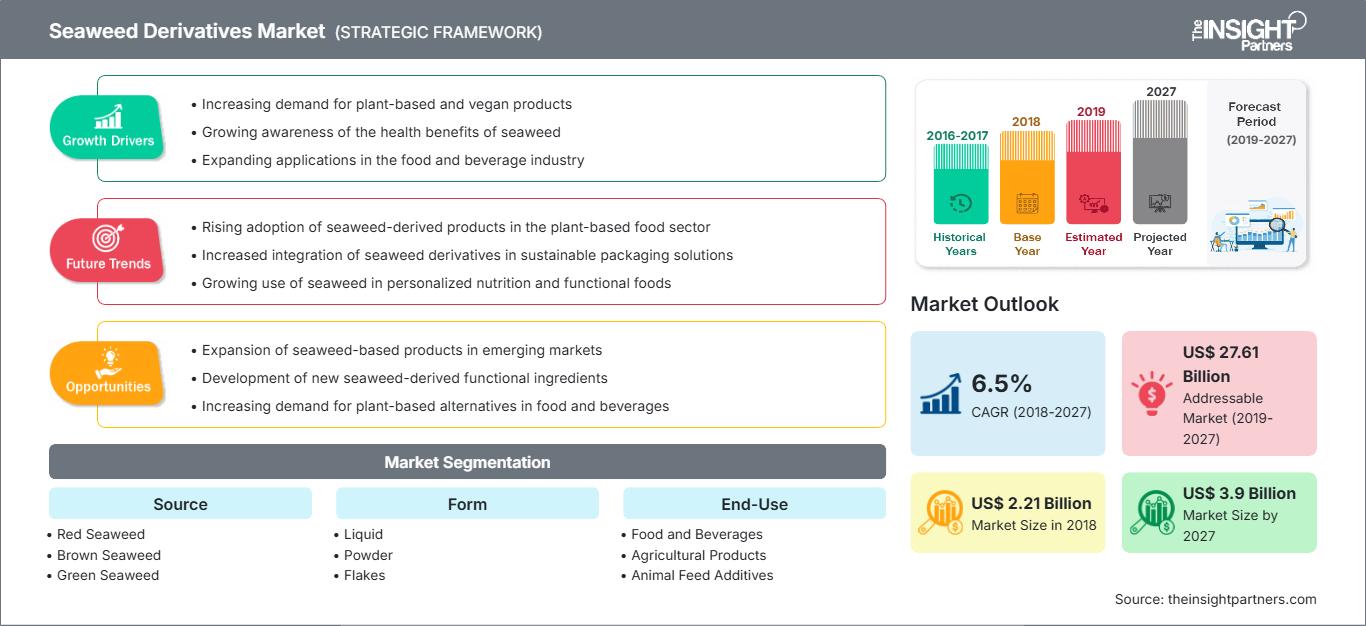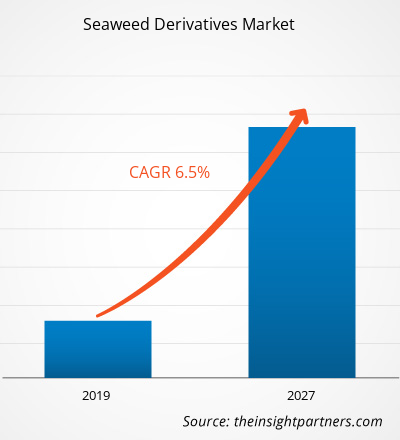El mercado de derivados de algas fue valorado en US$ 2.210,35 Mn en 2018 y se proyecta que alcance los US$ 3.903,91 Mn en 2027; se espera que crezca a una CAGR de 6,5% de 2019 a 2027.
Las algas marinas son básicamente microalgas marinas rojas, pardas y verdes, cuyos extractos se utilizan en cultivos hortícolas por sus efectos promotores del crecimiento vegetal. Los derivados químicos de las algas incluyen ácidos grasos y vitaminas, nutrientes minerales, fitoarmonas y polisacáridos complejos, entre otros. Los principales derivados de las algas marinas son los alginatos, las carrageninas y los agares. Los alginatos se extraen principalmente de las algas pardas, mientras que las carrageninas y los agares se extraen principalmente de las algas rojas. Los alginatos, las carrageninas y los agares se utilizan cada vez más en la industria alimentaria, de bebidas, de piensos y agrícola, entre otras.
En 2018, Asia Pacífico tuvo la mayor participación en el mercado mundial de derivados de algas, seguida de Europa y América del Norte. La creciente demanda de la industria de alimentos y bebidas, piensos y agricultura impulsa principalmente el mercado en la región de Asia Pacífico. China, Corea del Sur y Japón son los principales productores y consumidores de derivados de algas en la región. El mercado se ve impulsado principalmente por la aplicación más amplia de derivados de algas en la industria de alimentos y bebidas. Su uso cada vez mayor en fertilizantes mejora el rendimiento de los cultivos y aumenta su vigor, lo que contribuye a la resistencia a las plagas. La creciente concienciación de los consumidores sobre los beneficios para la salud de los derivados de algas está impulsando considerablemente el mercado de algas. Además, la creciente demanda de productos alimenticios orgánicos impulsa el crecimiento del mercado de derivados de algas. La menor concienciación entre los agricultores sobre la extracción de algas frena el crecimiento del mercado de derivados de algas.
El brote de COVID-19 comenzó en Wuhan (China) en diciembre de 2019 y, desde entonces, se ha extendido rápidamente por todo el mundo. China, Italia, Irán, España, la República de Corea, Francia, Alemania y Estados Unidos se encuentran entre los países más afectados en cuanto a casos positivos y fallecimientos reportados hasta marzo de 2020. El brote de COVID-19 ha afectado a las economías e industrias de varios países debido a confinamientos, prohibiciones de viaje y cierres de negocios. La industria mundial de alimentos y bebidas es una de las principales que sufre graves interrupciones, como interrupciones en la cadena de suministro, cancelaciones de eventos tecnológicos y cierres de oficinas, como resultado de este brote. Por ejemplo, China es el centro mundial de la manufactura y el mayor proveedor de materias primas para diversas industrias. El colapso general del mercado debido a la COVID-19 también está afectando el crecimiento del mercado de derivados de algas debido al cierre de fábricas, obstáculos en la cadena de suministro y la recesión de la economía mundial.
Personalice este informe según sus necesidades
Obtendrá personalización en cualquier informe, sin cargo, incluidas partes de este informe o análisis a nivel de país, paquete de datos de Excel, así como también grandes ofertas y descuentos para empresas emergentes y universidades.
Mercado de derivados de algas: Perspectivas estratégicas

-
Obtenga las principales tendencias clave del mercado de este informe.Esta muestra GRATUITA incluirá análisis de datos, desde tendencias del mercado hasta estimaciones y pronósticos.
Perspectivas del mercado
La creciente demanda de la industria de alimentos y bebidas ha favorecido el mercado de derivados de algas a nivel mundial.
Los derivados de algas marinas, como los agares, los alginatos y los carragenanos, se utilizan ampliamente en diversos productos alimenticios y bebidas. Estos derivados se utilizan en una amplia gama de alimentos y bebidas, como helados, jarabes, fiambres, fórmulas infantiles, leche de almendras, crema batida, barras de chocolate, leche con chocolate, bebidas de café (p. ej., café helado y bebidas de café a base de soya), crema para café, queso ricotta, yogur, requesón y crema agria, entre otros. Los carragenanos se utilizan como espesantes en pudines, leche con chocolate, chicles, mermeladas y jaleas. Además, los carragenanos reducen el desperdicio al extender la vida útil de los alimentos sin pérdida de calidad. Varios alimentos, como la mayonesa y los aderezos para ensaladas, se separarían sin la ayuda de un estabilizante. Por lo tanto, el carragenano se utiliza como agente estabilizante en la mayonesa y los aderezos para ensaladas. Por lo tanto, una amplia gama de aplicaciones de los derivados de algas en la industria de alimentos y bebidas impulsa el crecimiento del mercado de derivados de algas a nivel mundial.
Información sobre fuentes
Según las fuentes, el mercado de derivados de algas se segmenta en algas rojas, algas pardas y algas verdes. En 2018, el segmento de algas rojas representó la mayor participación en el mercado mundial de derivados de algas. Las algas rojas suelen tener los niveles más altos de proteína, lo que les confiere su color rojo. A pesar de encontrarse en aguas poco profundas, las algas rojas son capaces de resistir aguas profundas y condiciones de poca luz. Estos factores impulsan el crecimiento del mercado de derivados de algas rojas.
FormInsights
Según su forma, el mercado de derivados de algas se segmenta en líquido, polvo y escamas. En 2018, el segmento líquido representó la mayor participación en el mercado mundial de derivados de algas; sin embargo, se espera que el segmento en polvo registre el mayor crecimiento durante el período de pronóstico. Los derivados líquidos de algas pardas se comercializan para su uso en horticultura y agricultura. Estos derivados líquidos se utilizan en altas diluciones, lo que resulta en una aplicación mínima de material en la zona. Los principios activos de los derivados líquidos de algas son capaces de soportar temperaturas tan bajas.
Información sobre el uso final
Según su uso final, el mercado de derivados de algas se segmenta en alimentos y bebidas, productos agrícolas, aditivos para piensos, productos farmacéuticos y otros. En 2018, el segmento de alimentos y bebidas representó la mayor participación del mercado mundial de derivados de algas; sin embargo, se espera que el segmento de aditivos para piensos registre la tasa de crecimiento más rápida durante el período de pronóstico. Los derivados de algas, como los alginatos, se utilizan ampliamente en productos de panadería, dulces, lácteos, aderezos para ensaladas, helados, cremas y jaleas, así como en embutidos, carnes procesadas y pescado. También se utilizan para clarificar cervezas y vinos. Los alginatos son completamente orgánicos y seguros para su aplicación en alimentos. Además, pueden espesar una solución al disolverse en agua. Además, pueden formar geles al añadirse a una solución de sales de calcio. Por lo tanto, se utilizan principalmente en aderezos para ensaladas y mayonesa.
Perspectivas regionales del mercado de derivados de algas
Los analistas de The Insight Partners han explicado detalladamente las tendencias regionales y los factores que influyen en el mercado de derivados de algas durante el período de pronóstico. Esta sección también analiza los segmentos y la geografía del mercado de derivados de algas en América del Norte, Europa, Asia Pacífico, Oriente Medio y África, y América del Sur y Central.
Alcance del informe sobre el mercado de derivados de algas
| Atributo del informe | Detalles |
|---|---|
| Tamaño del mercado en 2018 | US$ 2.21 mil millones |
| Tamaño del mercado en 2027 | 3.900 millones de dólares estadounidenses |
| CAGR global (2018-2027) | 6,5% |
| Datos históricos | 2016-2017 |
| Período de pronóstico | 2019-2027 |
| Segmentos cubiertos |
Por fuente
|
| Regiones y países cubiertos |
América del norte
|
| Líderes del mercado y perfiles de empresas clave |
|
Densidad de actores del mercado de derivados de algas: comprensión de su impacto en la dinámica empresarial
El mercado de derivados de algas está creciendo rápidamente, impulsado por la creciente demanda del usuario final debido a factores como la evolución de las preferencias de los consumidores, los avances tecnológicos y un mayor conocimiento de los beneficios del producto. A medida que aumenta la demanda, las empresas amplían su oferta, innovan para satisfacer las necesidades de los consumidores y aprovechan las tendencias emergentes, lo que impulsa aún más el crecimiento del mercado.

- Obtenga una descripción general de los principales actores clave del mercado de derivados de algas marinas
Mercado mundial de derivados de algas marinas (por origen)
- Algas rojas
- Algas pardas
- Algas verdes
Mercado global de derivados de algas marinas: por formato
- Líquido
- Polvo
- Copos
Mercado mundial de derivados de algas marinas: por uso final
- Alimentos y bebidas
- Productos agrícolas
- Aditivos para piensos animales
- productos farmacéuticos
- Otro uso final
Perfiles de empresas
- W Hidrocoloides, Inc.
- Corporación KIMICA
- DuPont de Nemours, Inc.
- Gelymar S.A.
- CP Kelco
- ALGAS
- Compañía Española de Algas Marinas, S.A.
- Cargill, Incorporated
- ARTHUR BRANWELL Y CÍA.
- AGARMEX, S.A. DE CV
- Análisis histórico (2 años), año base, pronóstico (7 años) con CAGR
- Análisis PEST y FODA
- Tamaño del mercado, valor/volumen: global, regional y nacional
- Industria y panorama competitivo
- Conjunto de datos de Excel
Informes recientes
Testimonios
Razón para comprar
- Toma de decisiones informada
- Comprensión de la dinámica del mercado
- Análisis competitivo
- Información sobre clientes
- Pronósticos del mercado
- Mitigación de riesgos
- Planificación estratégica
- Justificación de la inversión
- Identificación de mercados emergentes
- Mejora de las estrategias de marketing
- Impulso de la eficiencia operativa
- Alineación con las tendencias regulatorias






















 Obtenga una muestra gratuita para - Mercado de derivados de algas
Obtenga una muestra gratuita para - Mercado de derivados de algas